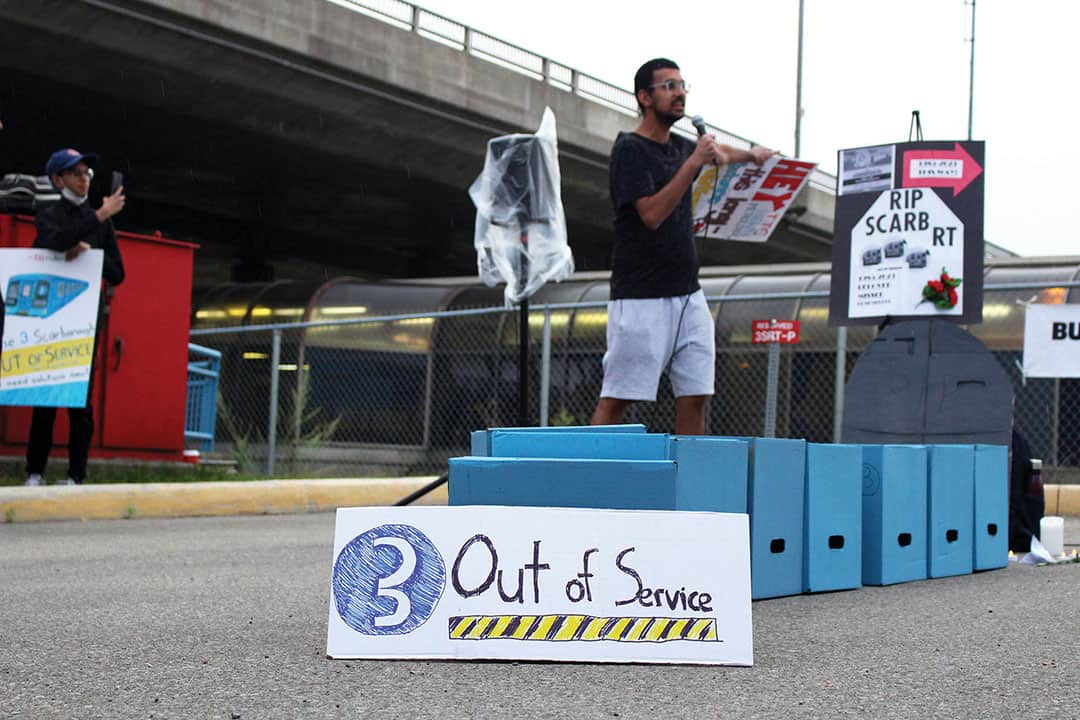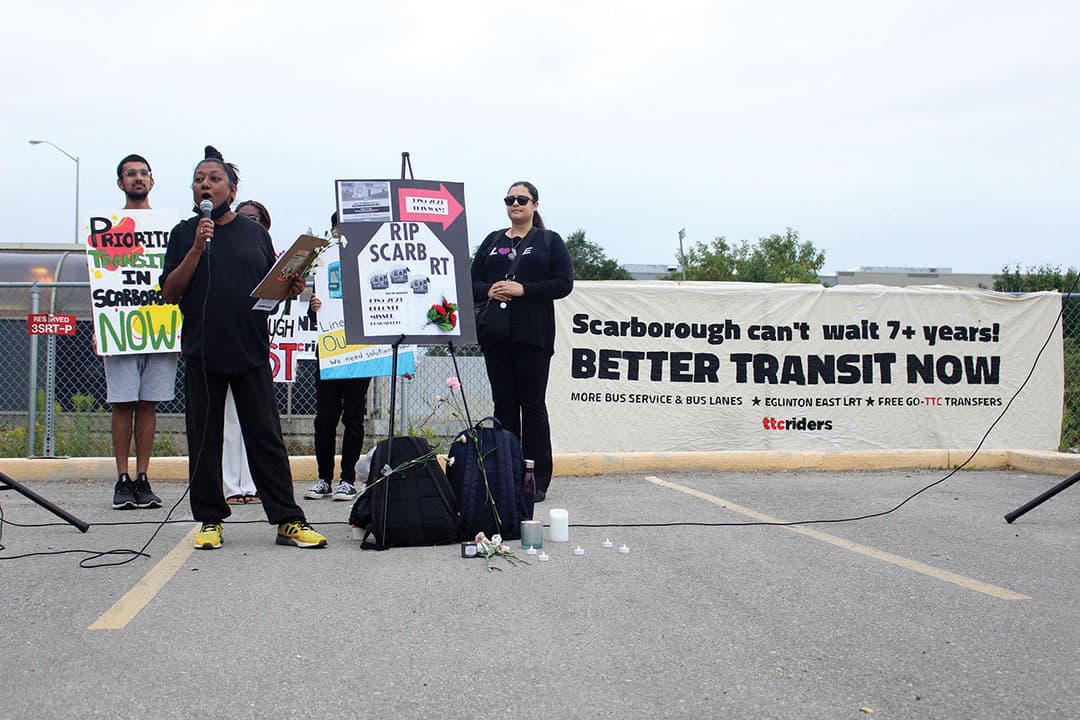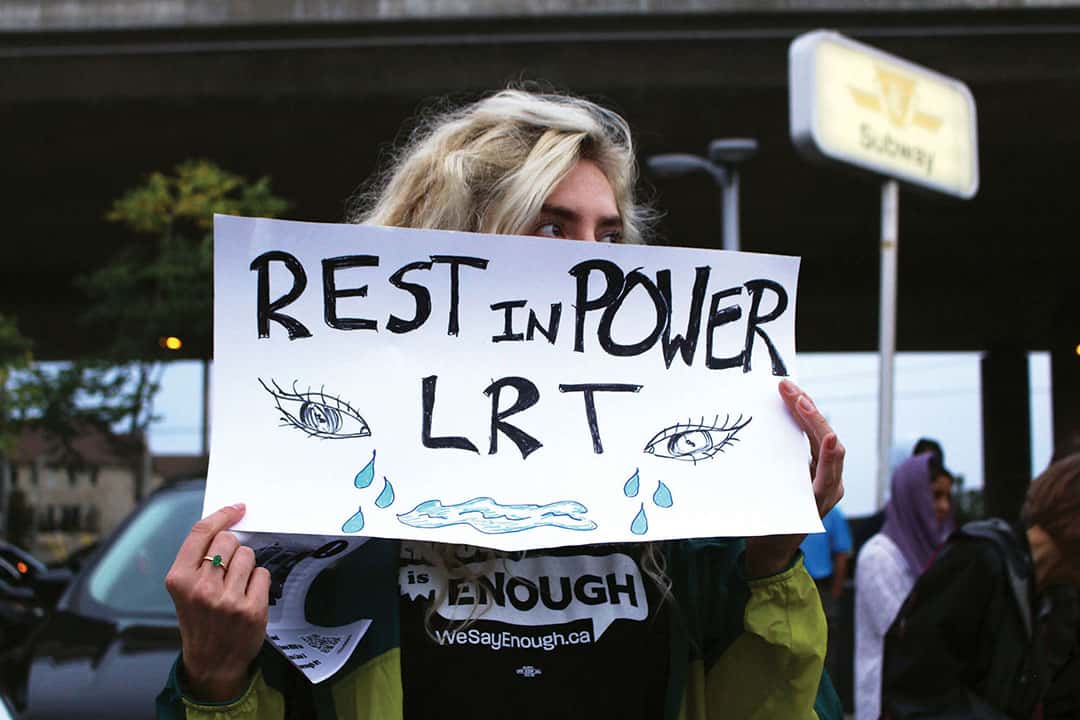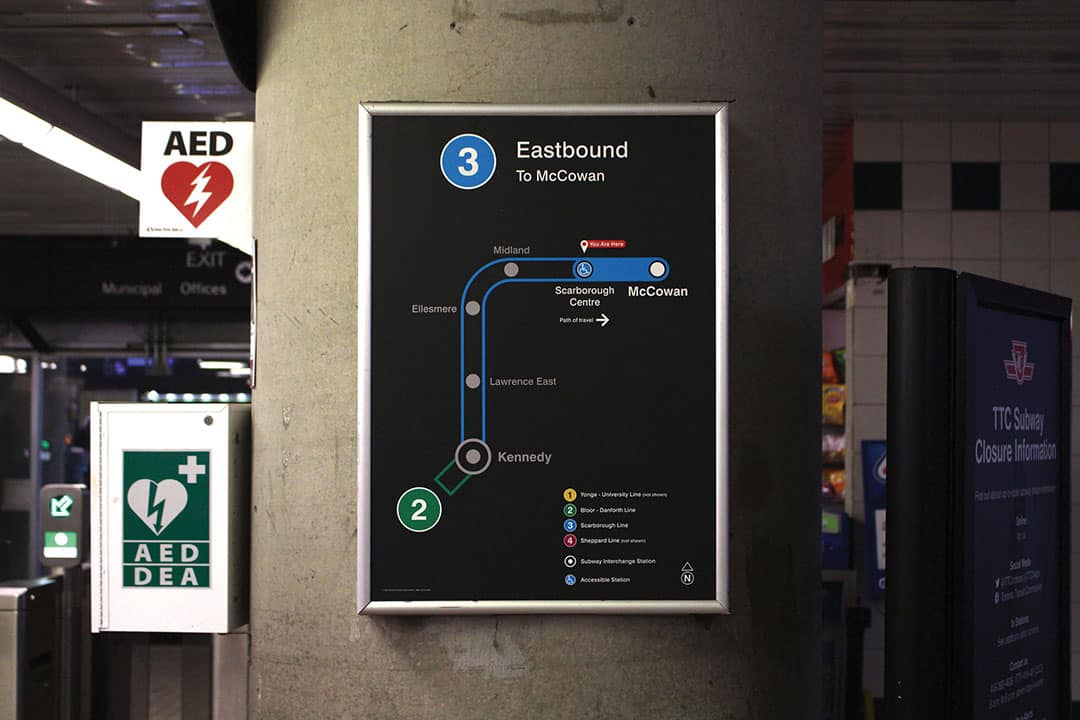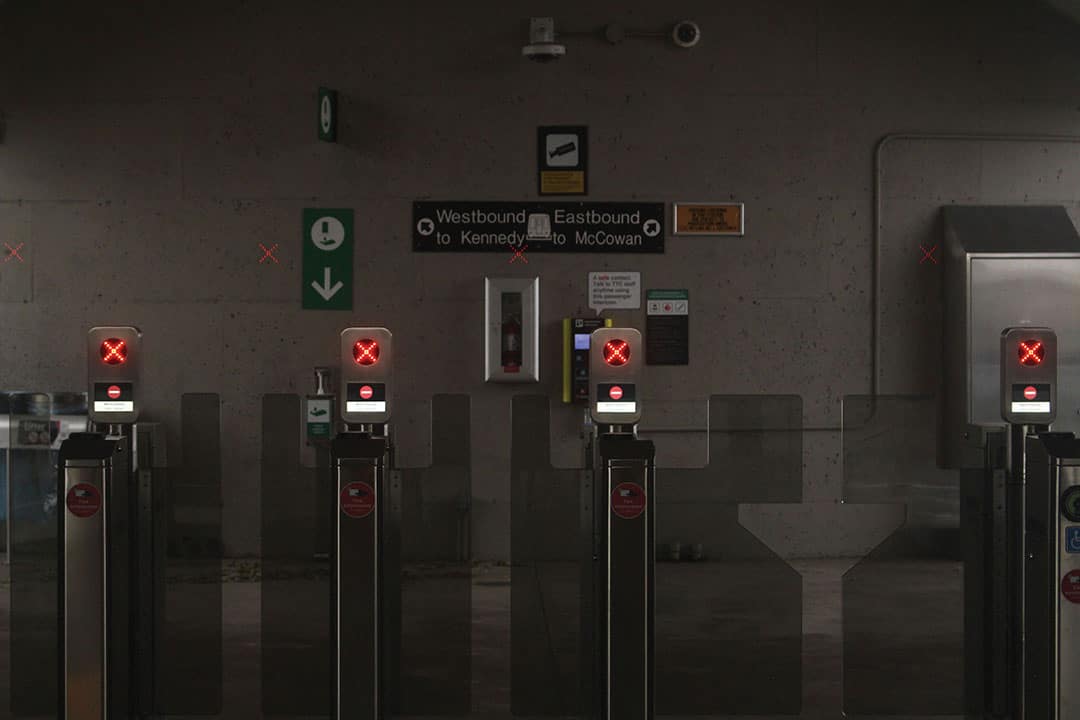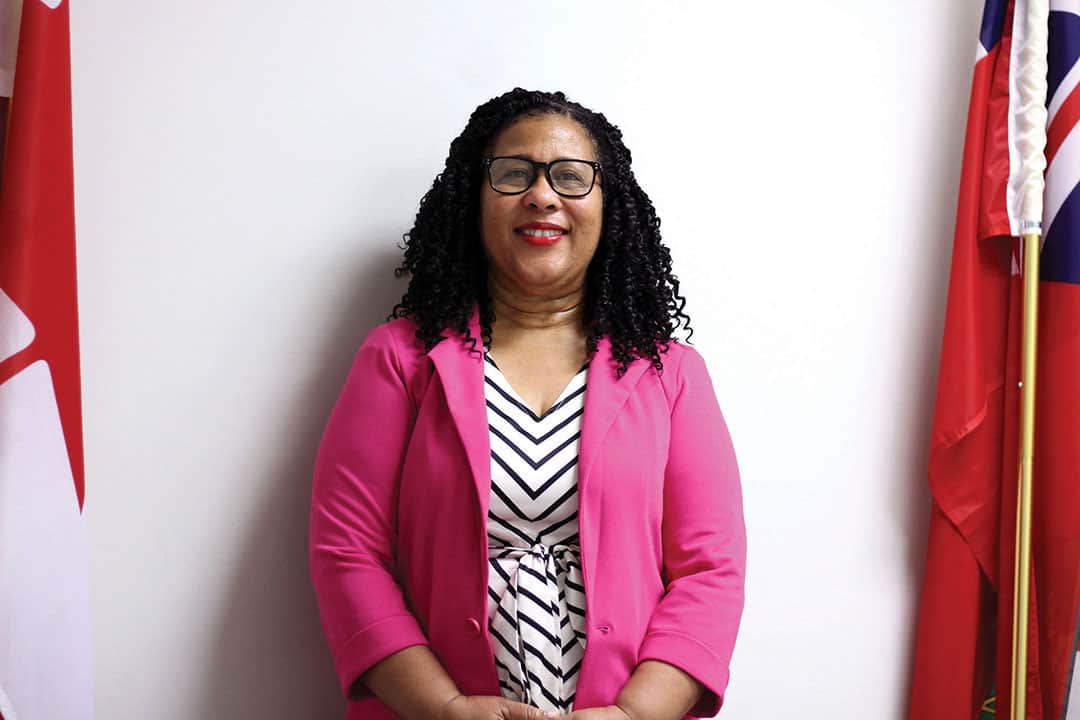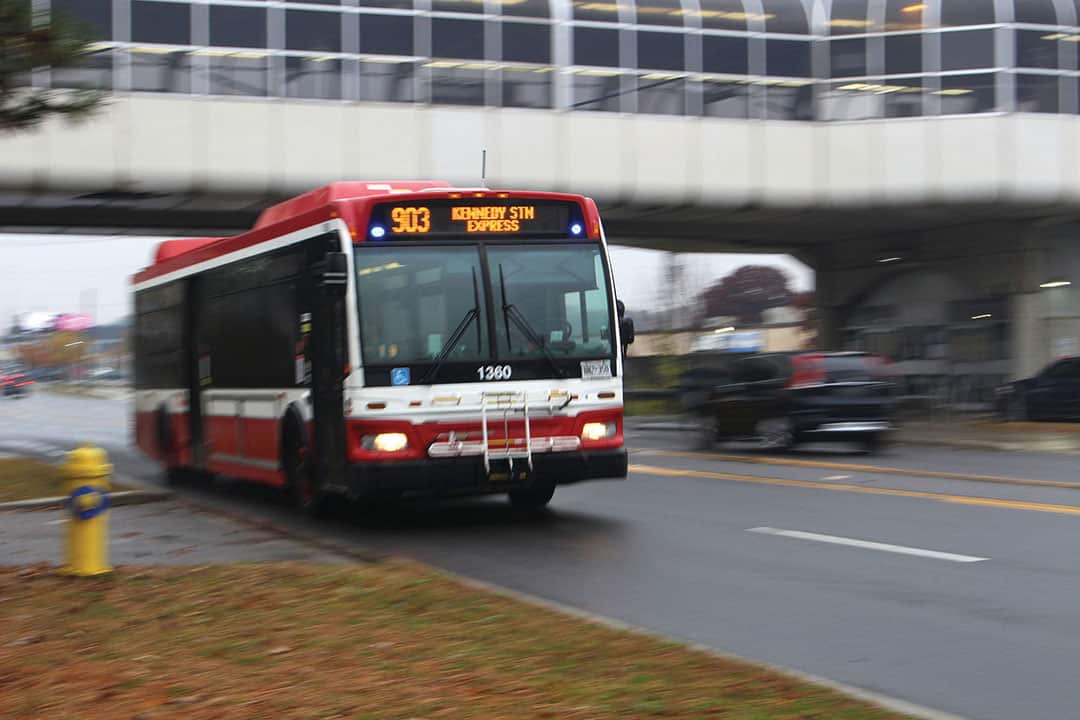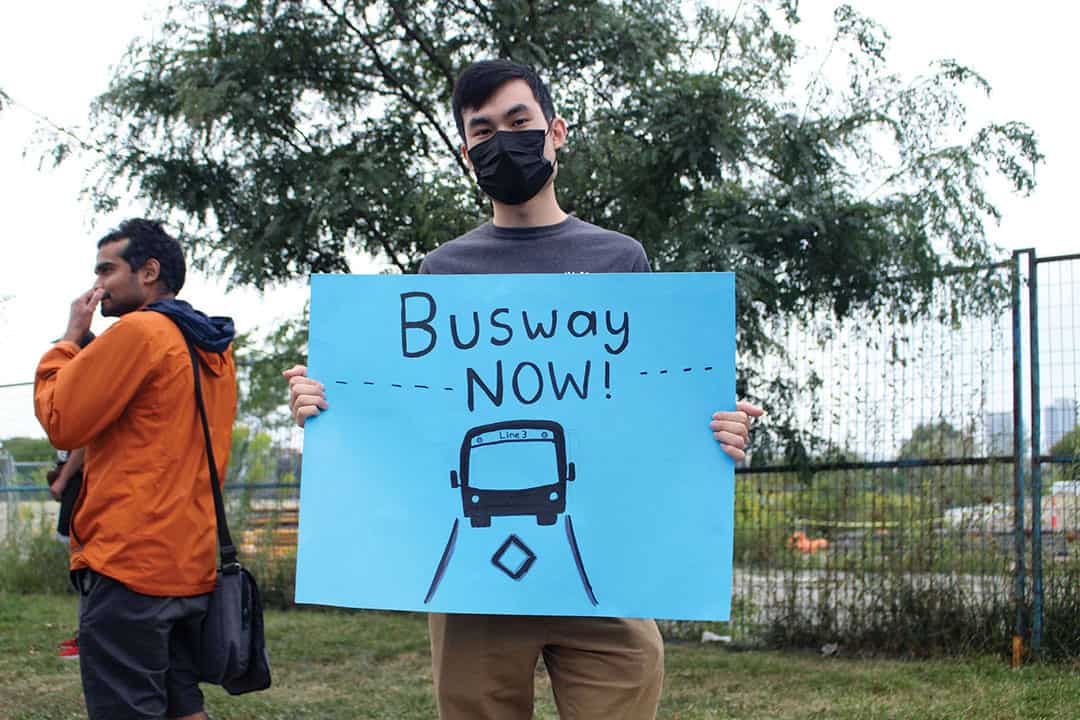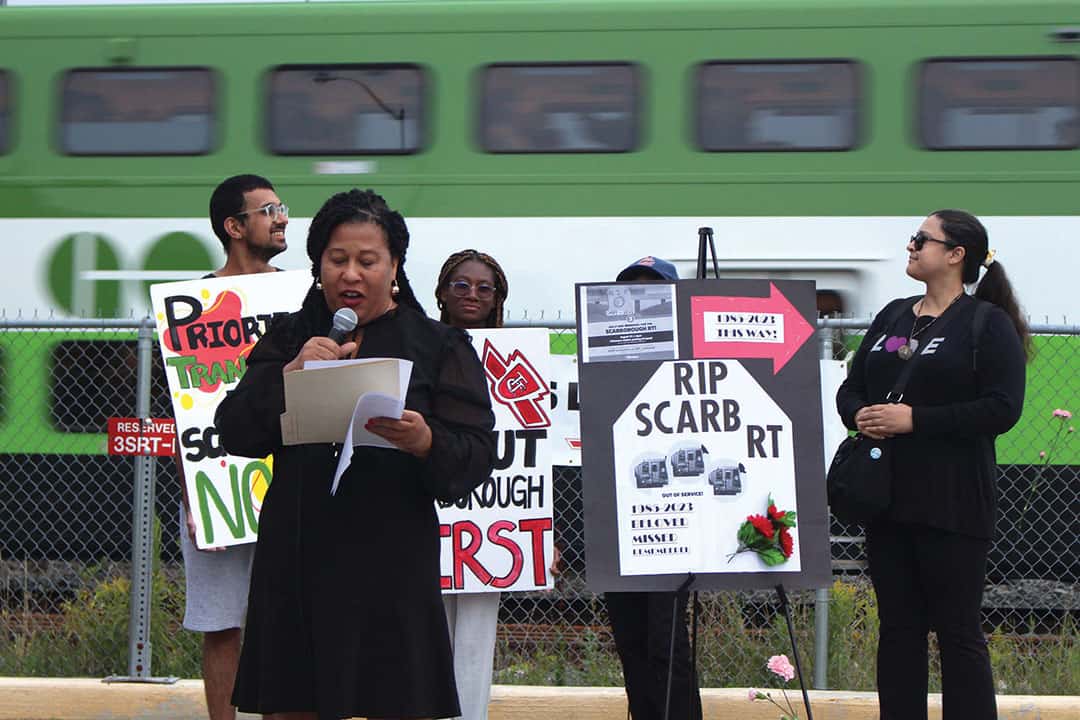“Gone, but never forgotten. RT — 1985-2023.” This was one of many farewell messages written on paper cards and tied onto a blue railing behind Ellesmere Station — one of the six stations that made up Scarborough’s Line 3.
From among the crowd, a group of six people carried an interconnected line of blue cardboard boxes to the parking lot’s centre. As they placed the boxes on the ground, people saw a miniature version of Scarborough’s iconic blue Rapid Transit (RT) line emerge.
It was a rainy Wednesday afternoon. August 23, 2023 marked the end of my summer semester as I finished my last exam. Little did I know, it also marked the end of my time with the RT line. On my way home, I saw an Instagram post inviting the public to attend a memorial for the RT system later that evening, and I rushed to grab my camera and hopped onto the next bus to Ellesmere Station where the memorial was being held.
Near the station entrance stood a volunteer from the TTC Riders — a grassroots volunteer-based organization advocating for better transit in Toronto that had planned the memorial. Customers held signs in tribute to Line 3. One read: ‘RIP SCARB RT.’ The pathway led to the east parking lot of the station, where people dressed in black gathered to mourn the death of Line 3.
Attendees brought posters and signs that exclaimed their frustration and demands for better transit in Scarborough. Media cameras pointed toward an open microphone where representatives from non-governmental organizations, student bodies, and MPPs addressed how deeply embedded Line 3 was to life in Scarborough.
“[The] RT rally was… a call to action. Because we wanted to see solutions happen to make life easier for people who use the Scarborough RT, and it’s now shut down,” said August Puranauth, a community planner with TTC Riders.
As the event became a news story broadcasted to other parts of the GTA and Canada, the word “Shame!” reverberated through the air as the crowd reflected on the municipal and provincial government’s dismissive attitude towards improving transit in Scarborough.
The derailment
On July 24, 2023, tragedy haunted the Scarborough community when an RT train car derailed. The derailment caused minor injuries among five people with no casualties. According to a CBC article, Toronto Transit Commission (TTC) CEO Rick Leary said that loose bolts on the tracks were the cause of the derailment. After the accident, the TTC launched a one-month investigation into the deterioration of RT infrastructure before officially ending Line 3’s life early.
Initially, the TTC had planned to decommission the RT in November 2023. Line 3 had been running for 38 years, since 1985 — 13 years past its design life. The extension of its lifespan was a result of the lengthy debates and indecisions between city councillors regarding how the City should build public transit in Scarborough.
As someone who lives in the heart of Scarborough, even when LIne 3 was running, a normal commute to St. George Station in downtown Toronto took me approximately an hour and 10 minutes on a good day. I would take a bus to reach McCowan Station — the terminal of Line 3 — and ride the RT to Kennedy before transferring onto Line 2. Although rickety and loud, the RT was an important link for me to reach other areas of Scarborough and the GTA.
In place of the departed Line 3, the TTC deployed shuttle buses starting August 26 to take residents between Scarborough Centre Station and Kennedy Station. According to the TTC website, it runs up to 70 shuttle buses per hour. Unlike RT, however, shuttle buses do not have a designated path separated from road traffic.
Inevitably, commute times slowed down. Red lights, traffic congestion, and waiting times have created a loop that significantly lengthens my commute time by at least 20 minutes. With Line 3 permanently closed, residents are stuck in this loop with no other solution than to accept the circumstances of their reality.
The death of Line 3 is emblematic of a bigger issue. This aging route operated far beyond its years — it had to be decommissioned at some point. However, the lack of a concrete plan ready to be implemented after the death of Line 3 reflects a longstanding pattern of City Hall treating Scarborough with neglect.
Shuttle buses: An inadequate replacement
The barrage of shuttle buses is only a temporary solution while a subway extension is under construction. In place of Line 3, Metrolinx is building the Scarborough Subway Extension. This project extends Line 2 into the heart of Scarborough with three additional stops: Lawrence, Scarborough Centre, and Sheppard.
According to Metrolinx, the goal of this project is to provide “quick and seamless transit” for those travelling between Scarborough and downtown Toronto. This might sound like an ideal plan. However, according to the Metrolinx website, the project only began construction in January 2023 and will not be ready until at least 2030. As of now, Scarborough residents face at least seven years where they will be forced to rely on shuttle buses.
Ruan Negi, a first-year Rotman Commerce student who grew up and lives in Scarborough, believes that the disadvantages of the shuttle buses outweigh the advantages. Despite the buses arriving approximately every one to two minutes to mimic a subway system, their route is not separated from road traffic. Consequently, factors such as road congestion, traffic lights, and rush hour impact commuters.
“It’s more stressful now [to] commute to St. George,” Negi says. For his 9:00 am classes, Negi has to wake up three hours before and ensure he leaves home at 7:30 am. Despite leaving an hour and a half before this class, Negi has to take more precautions than usual in case of unpredictable delays on the road. As a result, he faces the likelihood of spending more time on the road than expected due to factors outside of his control.
The 70 shuttle buses do not compensate for residents’ reduced transit access. Many transit riders live in an area that does not have a direct route to a TTC station to catch a shuttle bus.
Ashley Heng, a recent UTSC graduate, takes three transit routes to get to her workplace near St. Andrew Station. Heng lives in a neighbourhood with only one bus route. When the RT was functioning, the 54 bus would take her to Lawrence East Station where she could take Line 3 to reach Kennedy and transfer to Line 2. Without the RT, the 54 still runs, but the shuttle bus does not stop at Lawrence East Station. Rather, it stops less than an intersection away, and she has to walk the remaining distance.
Commuters’ waiting times have ballooned as transit timing has become more crucial. One slight delay could add up and significantly lengthen commute time. For Heng, it’s now more convenient for her to take a bus to Guildwood GO station and go from there on the GO train to Union Station. However, transferring to GO Transit from the TTC prompts her to pay two fares.
Some could argue that driving is always an option. However, if a significant amount of people switched to driving cars, congestion and pollution in the city would only get worse. Puranauth further notes, “Many riders in Scarborough cannot afford to switch to cars.”
Although the shuttle buses have been a decent solution to compensate for Line 3, the City already had tangibly better alternatives it could have put in place. “After all the years of neglect in transit investments Scarborough has faced, this is really just a big slap in the face to transit riders in Scarborough,” Puranauth added.
“The forgotten land”
Line 3’s death is not the only issue for Scarborough’s transit crisis. It only exposed the government’s dismissive attitude towards the city. Scarborough is disproportionately racialized compared to the rest of the GTA. Plenty of residents migrated to this city for countless opportunities to start a new life.
Still, Heng personally believes that most people who live downtown are still unaware that Line 3 ever existed. Something that was so integral to the residents of Scarborough is but a myth in the minds of Torontonians. “I still don’t think that people understand the full extent of all of this [neglect],” they added.
“We’ve been left to just figure it out as commuters. How do we put trust back into the TTC, if we’re being treated like this?” said Andrea Hazell.
Hazell is the MPP for Scarborough-Guildwood, who was elected on July 27, 2023. In an interview with The Varsity, she reflected on how the fallout of the SRT derailment felt like another occurrence in a long pattern of neglect. “The government only remembers us at voting time,” she said. “Diversity, equity, and inclusion. We’re the number one [part of the] city for [diversity]. So… if we are needed by the government when election time comes around, why aren’t we important [when it comes to] living with quality?” she added.
Hazell has family members who depended on RT, like her son who goes to UTSG. Together with Heng and Ruan, Hazell expressed her concern over the unexpected delays when riding the shuttle buses. She mentions that her son sometimes takes an Uber to Kennedy “because he cannot risk waiting for the bus [to] get into Kennedy.” Suddenly, being on time comes with an extra cost. Commuters are left to figure it out by themselves.
It’s evident that Scarborough has been going through a transportation crisis. Unfortunately, this crisis is not only impacting people’s commutes but also other parts of their lives. “Businesses want to come into Scarborough to start their businesses and invest. [But] we have a transportation crisis, and it’s impacting our economy,” says Hazell.
The LRT, and what could have been
Scarborough residents were not doomed to live today’s reality. Nearly a decade ago, city councillors had started talking about replacement plans for the RT. One of these plans was a Light Rail Transit (LRT) system.
The LRT could be compared to downtown Toronto’s streetcars. “The big benefit of the Light Rail plan was that it would have more stops. It would have been cheaper overall to build [than the subway]… So, really, what that means was a lot more access to transit,” Puranauth said. According to a 2013 Toronto Star article, the LRT would have cost $1.8 billion to build, and span 10 kilometres with seven stations. The subway extension, however, cost $2.3 billion for 7.6 kilometres of track and three stations.
So, what happened? Why did this plan not turn into a reality?
Although the LRT would have greatly benefited Scarborough residents, Rob Ford seemed set against the concept. Under Rob Ford’s mayoralty, politicians like Ford pushed the idea that the subway system was superior to the LRT because it was entirely underground. Puranauth personally argues that this decision was not made out of concern for the future of Scarborough or for its betterment, but rather as a political decision to “[keep] transit out of traffic.”
The LRT discussion was so drawn out that the City failed to implement a solution before Line 3 permanently closed. In the end, city councillors rejected the LRT plan, contributing a manifactured transportation crisis that the government continues to dismiss. Significantly, city councillors and government members are not the ones facing the ramifications of their decisions — transit riders are.
The problem of winter
It has been about two months since the shuttle bus system completely replaced Line 3. With temperatures fluctuating this fall, more problems are on the horizon.
Negi and Heng express concerns about commuting with shuttle buses in the winter. Negi notes that regular drivers tend to rely more on public transport in the winter due to harsher driving conditions. On top of the existing transit riders, people who usually commute with cars will add on to the volume of people taking the shuttle buses.
Not only will each bus be more congested, but the buses will inevitably drive slower due to the snow. A more crowded and slower commute is a serious issue for riders with work, school, and other commitments.
Arguably, an underrated element of Line 3 is the stations themselves. Heng notes that when the RT was operational, Lawrence East Station acted as an enclosed space where commuters would wait for their next bus. Now, of the six RT stations that made up Line 3, only Scarborough Centre and Kennedy are still functioning transit stations. The other four stations are no longer open. With the current shuttle bus route, passengers get dropped off at an intersection where they will have to wait for their next bus in the cold.
Current solutions
The irony of the LRT cancellation is that the shuttle buses replacing the RT are embedded in road traffic.
City councillors have had discussions about solutions to alleviate transit commuters’ stresses. On September 3, the TTC implemented red bus lanes, a designated path for buses with the intention of separating the bus’ routes from regular traffic to accelerate commute times. This path was initially set to be completed late in November 2023, in time for the original Line 3 decommission date.
Despite the red bus lanes giving buses their own path, though, this route is still not separated from the road. Heng notes that she once took a shuttle bus to Lawrence East Station, only to be dropped off on another street due to road construction that was obstructing the red lanes.
Another planned solution by Metrolinx is an integrated fare between GO Transit and TTC. Unlike MiWay, York Region Transit, and other transit systems in and around the GTA, the TTC does not have an integrated fare system that allows riders to transfer to and from the GO for free. Instead, riders have to pay two fees, which means Heng’s alternative GO Transit route is not an accessible and affordable route for everyone.
GO Transit serves as an important link for commuters living outside the downtown core. Thus, it is ironic that the transit system of the largest city in the GTA does not have a fare system integrated with GO Transit when many riders commute from outside the city. According to a CTV article, former Associate Minister Of Transportation Stan Cho stated that the City will launch an integrated fare initiative by the end of the year. This has since been delayed to 2024.
Being able to improvise alternative routes on the go is not an ability every commuter has. If anything, it’s unfair to expect commuters to figure out transit routes when a delay happens. Heng reflects that not everyone is proficient in using navigational apps and understands their transit routes well.
A busway could be one solution for transit to be simpler, more reliable, and more convenient in Scarborough. Such a busway would completely operate separate from street traffic. Theoretically, this could save 10 to 15 minutes of commute time, according to Puranauth. Politicians like Olivia Chow have endorsed it, and Chow has committed to building one.
As convincing of a plan as the busway sounds, the provincial government has yet to fund and start such a project.
While city councillors, Metrolinx, and the TTC have been discussing the political and economic sides of Scarborough transit, freedom of movement around the GTA remains an overlooked conversation. The current 70 shuttle buses, the red bus lanes, and a possible integrated fare are great options, but they’re not enough for a quality life.
Pushing forward
The seemingly constant neglect Scarborough receives from the municipal government may seem disheartening. Still, advocates are fighting to make their voices heard in City Hall and change Scarborough for the better.
“[As a representative of] Scarborough, I’ve got to give that loud voice at Queen’s Park for Line 3 and the busway,” Hazell said in my interview with her. Since the start of her term, Hazell has strived to bring the voices of Scarborough onto the table in provincial parliament conversations in Queen’s Park. On October 5, 2023, during a parliament session, she posed a question to Provincial Minister of Transportation Prabmeet Singh Sarkaria on why the government won’t fund the busway plan, only for him to dodge her question.
“That was my first question. It’s not going to be my last question,” Hazell told me. She also revealed that she intends to meet with Vijay Thanigasalam — Ontario’s associate minister of transportation — to discuss the transportation crisis in Scarborough.
Puranauth explained that the Line 3 memorial that I witnessed on that rainy afternoon had two purposes: not only was it a call to action, but the rally also invited people to share stories about line three. Despite the deafening roar of the train, and the fact that it was operating on infrastructure that was truly on its last legs, Line 3 was central to life in Scarborough.
Hazell puts this importance into perspective. She cited a 2018 report, which stated that in that year, about 35,000 Scarborough residents commuted to a different city each day. “In those 70 buses, [there were] 35,000 commuters per day. [Doesn’t the City] care? About that massive commuter [population] in Scarborough that travel on these buses to make a living for their family?”
This, in part, is why Hazell and TTC riders fight so hard for a solution beyond the current bus service. And this advocacy has made progress for Scarborough’s transit. Puranauth notes that had it not been for the recent advocacy of TTC riders, the busway plan would not have even been considered. “The city [might] as well have just ran the buses in traffic for several years instead of building the busway, but the busway was put on the table with the help of advocates, and now we just need to get funded,” Puranauth said.
Hazell emphasized how important it is to get involved in advocacy, instead of simply toughing it out with poor transit infrastructure, like the residents of Scarborough have been forced to do time and time again. “Let’s get down to Queen’s Park and let’s [make] this happen. That’s what you do when you need to get things done. You stand up, you take action, and you get the results.”


